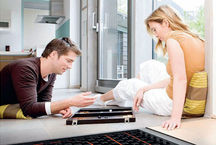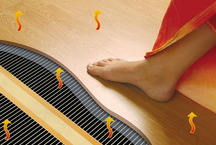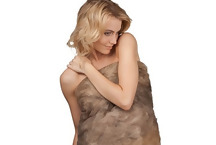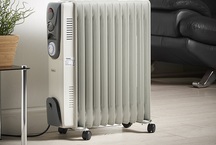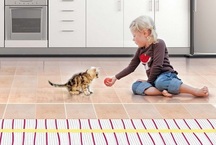What unites you and the rich citizens of ancient Rome? You will be surprised - the desire to heat the floor in the house and the ability to do it. Yes, underfloor heating was available in many wealthy houses of the Roman Empire. And now you can afford it. In this article, you will learn about 15 facts that will help you choose the best floor heating for your home and avoid mistakes when installing it.
Fact 1: The heating system increases the level of the floor in the room. Most of the space takes the warm floor water, the least - film.
The usual diameter of pipes through which coolant flows is 20 mm. Add to this the thickness of the screed - and you will understand how much higher your floor will become. The cable system must be laid in a screed thickness of about 5 cm. The heating mats can be laid in a layer of tile adhesive - and the floor thickness will not increase due to the heating system. Underfloor heating floor in itself has a minimum thickness and will not affect the height of the room. If every centimeter matters to you, choose a thermomat or film. To maintain a minimum floor level, warm floors of the Thermolux-Tropix series are suitable. Modification 160 is used in warm rooms (including children’s). The system Thermolux-Tropix-200 is applicable for cold rooms (country houses, balconies, etc.).
Fact 2: for a country house, a cottage the most energy-efficient warm floor is water.
In country houses warm floor is often used as the main source of heat. For example, products manufactured by Kermi (Germany) - metal-plastic and polyethylene pipes are used in floor heating systems and radiator heating. When it is required to heat a large area, water floor heating is more profitable, since it practically does not consume electricity. Hot water moves from the collector through the pipes using a pump, and electric energy is not spent on changing the air temperature.
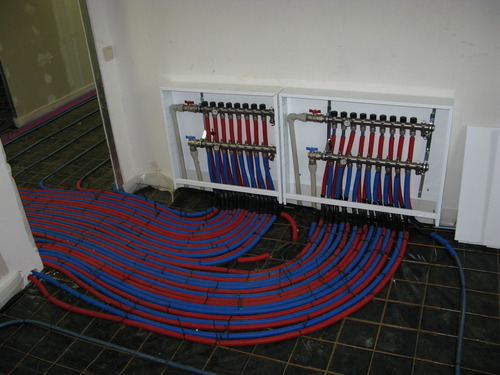
Fact 3: In many city apartments the installation of a water heated floor is prohibited. The only possible solution in this case is the electrical system.
Without coordination with the service organization, it is not possible to connect any devices to the central heating. This also applies to water warm floors. The water from the common riser, passing through the floor heating pipes, gives off heat and enters the neighboring apartments partially cooled. The pressure in the common system goes down. You can install a water floor in the city only in new modern houses, in which builders have provided a separate riser specifically for this purpose.
Fact 4: electric underfloor heating allows you to quickly adjust the temperature in the room. In water, sometimes this is not possible at all.
If the water floor is connected to the centralized heating or to the heating boiler, then the coolant temperature does not depend on you. Even if there is a separate riser and thermostat, instantly change the heating will not work, the water temperature will change gradually. The newest setting is infrared floor heating. When you turn it on you very quickly feel the heat. Some models have the function of self-regulation - for example, film CALEO GOLD 170-0,5-2,0. Thanks to this function, electricity is more economical - with increasing floor temperature, power consumption decreases.
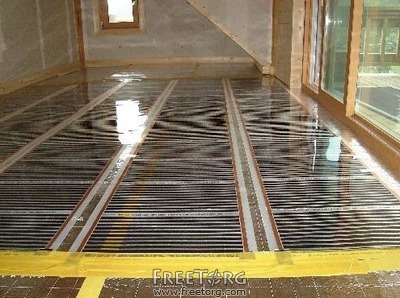
Fact 5: Finding and repairing a damaged area of an electric underfloor is easier than finding and repairing damage to a water floor.
The faulty part of the cable, where there is no voltage, the specialist can find quickly and with great accuracy. To replace a piece of wire, you will not need to open the entire floor. If the pipe is damaged, the leakage is not so easy to find. To fix the system, the floor will most likely have to be disassembled.
Fact 6: a heated floor with insulation increases its efficiency by 30-40%.
Heated floor without insulation equally heats your room and the lower apartment or basement. In order not to waste energy in vain, heat insulation (for example, penofol) must be laid with the bottom layer of a warm floor. Under a thin heat-insulated floor (for example, the Thermal-Thermolux-Mini thermo with a grid thickness of 1 mm, cable - 3 mm), thermal insulation is not installed due to the requirements of the construction documentation for the strength of the floors - it is placed only under the screed layer. In this case, the heat loss downward will be insignificant, as the screed will delay it.
Fact 7: The type of floor covering influences the performance of a heated floor (its ability to conduct heat, installation methods, resistance to heat).
When choosing a floor heating system, keep in mind that the floor, covered with tiles, will effectively heat the cable, thermomats. Ideal under floor heating under linoleum, laminate (thin materials) - thermal film. It is not recommended to install a warm floor under the parquet, as the wooden flooring may dry out from the heat. Under the thick carpet - it is impractical (heat to your feet will not even reach).
Fact 8: If you put a warm floor under the topcoat, which has doubts, the consequences can be unpleasant.
With good flooring under the action of a warm floor, nothing will happen. Cheap low-quality linoleum, even with such a small heat can be deformed and start to smell.
Fact 9: no need to lay warm floor throughout the area of the room. And in some cases, such installation may even lead to the cancellation of the warranty.
First, it is an extra power consumption. Why heat the floor area on which there is a wardrobe? Secondly, the elements of the heated floor, which are under the sofas, cabinets, carpets, etc., will overheat and fail before the expiration date.
Fact 10: after installing a warm floor you should have a layout plan in your hands.
The laying scheme should include the lines of the cable, the distance to the walls, the location of the plumbing equipment, the location of the couplings. If a preliminary scheme has been drawn up, final marks can be made on it. Otherwise, you will need a metal detector to accurately determine areas where you can not drill the floor, install furniture or new plumbing.
Fact 11: The same heating system should not be laid in rooms with different temperature conditions.
Floor heating in the bedroom and, for example, on the balcony should be arranged individually. The desire to save and mount a single system will not lead to anything good. It is also impossible to extend the wire and increase the area of the already laid heated floor. Therefore, calculate the capacity of the floor for each room separately.
Fact 12: Infrared floor heating should not be laid wet.
You should know that the film, which forms the basis of the infrared heat-insulated floor, is afraid of aggressive media. In particular, the alkaline environment of tile glue or cement-sand mixture can damage it. Therefore, the film is laid only "dry".
Fact 13: for the nursery, living room, bedroom, you should use an electric underfloor heating system based on a twin cable. For balconies, bathrooms, corridors, you can use single-core cable.
Around the electric wire there is an electromagnetic field. The permissible value of it is set in SNiP. Electric floor heating cables also create electromagnetic fields. But the radiation level is small. In addition, the design of the cable includes a layer of shielding braid. Thanks to it, the radiation of a single-core cable is almost 60 times less than permissible. The heat-insulated floor of the British manufacturer Energy Light 0.5 - 50 can be used in dry rooms with any kind of flooring. The cable thickness is only 2.8 mm, and it is surrounded by a solid screen of aluminum foil and copper braid.
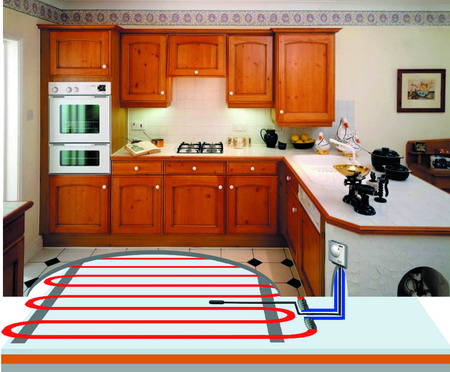
Photo: stylehome.org
Strong cable, which is recommended for installation in rooms where people are constantly, has a radiation level of 300 times less than the permissible value. Therefore, it is completely safe. As an example, we give a warm floor of the same company - Energy Light Plus 8.0-1200. Cable diameter - 3.6 mm, can be used in wet rooms, under the tile, porcelain. Working temperature - up to 27 °.
Fact 14: A thermal sensor that monitors the temperature of the floor heating should be placed in a special corrugated tube and placed close to the wall in an inconspicuous corner..
Thermal sensor failure is one of the most common problems. If the sensor is tightly filled with cement, the floor will have to be opened. This is easily avoided. if in advance to place the sensor in a plastic corrugation. Then, even after the final finishing of the floor, the sensor can be safely removed and, if necessary, replaced.
Fact 15: it is necessary to flood the floor immediately after laying the cable, and it is possible to turn on the heating system no sooner than the screed has completely dried. It should take about a month!
It is necessary that the mixture is dried naturally. It is impossible to accelerate this process by turning on the heating - under the action of the temperature, the cement will set unevenly and the screed will be fragile. When laying a heat-insulated floor use mixes which are intended for this purpose. Look for the appointment and drying time on the packaging.
So what have we learned? For a house outside the city suitable water-heated floor, electric should be used for local heating. In urban apartments the installation of water floors may be impossible, but electric ones are quite acceptable. The choice of the type of electrical heating system is directly related to the characteristics of the device of the main floor (screed, finishing coating).
